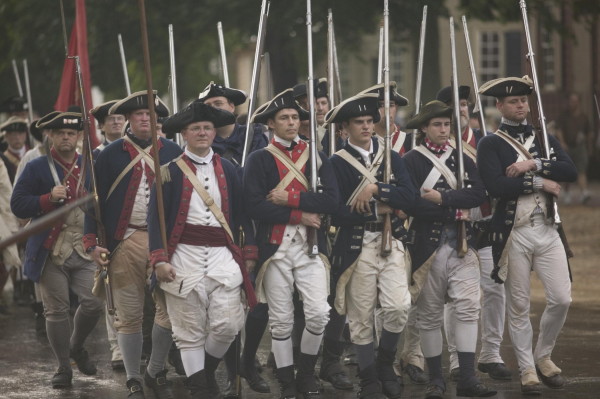 Like so many other Revolutionary events, the road to Yorktown started in Williamsburg. And on the weekend of October 10-11, 234 years after British musicians played “The World Turned Upside Down” as the British forces under Cornwallis surrendered, the run-up to that historical battle will be replayed as Washington’s Army Descends on Williamsburg.
Like so many other Revolutionary events, the road to Yorktown started in Williamsburg. And on the weekend of October 10-11, 234 years after British musicians played “The World Turned Upside Down” as the British forces under Cornwallis surrendered, the run-up to that historical battle will be replayed as Washington’s Army Descends on Williamsburg.
On Sept. 14, 1781, a feverish Marquis de Lafayette greeted Gen. Washington as he arrived in Williamsburg “with an ardour not easily described.” Washington had just come from a brief stopover at Mount Vernon, his first visit home in six long years.
He was accompanied by the comte de Rochambeau, who headed the French troops. Over the next ten days, troops poured into Williamsburg, some on foot, others by ship: at College Creek, Burwell’s Landing, and Jamestown.
They set up camps and made preparations for the coming siege at Yorktown. So what would that have looked like?
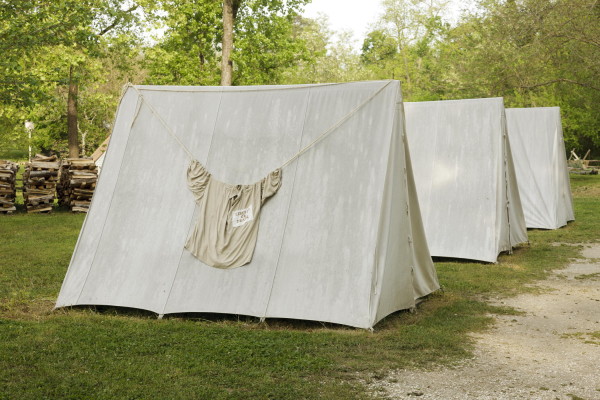 Visitors on October 10-11 won’t have too much trouble imagining the scene. The action will be conspicuous all over town, including the grounds of the Wythe House, which served as Washington’s military headquarters. Nearly a dozen regiments of Revolutionary War reenactors, led by the 7th Virginia, will bring the town alive with military preparations.
Visitors on October 10-11 won’t have too much trouble imagining the scene. The action will be conspicuous all over town, including the grounds of the Wythe House, which served as Washington’s military headquarters. Nearly a dozen regiments of Revolutionary War reenactors, led by the 7th Virginia, will bring the town alive with military preparations.
You won’t be able to miss the scores of tents on the Palace Green and Market Square. Expect to meet officers, enlisted personnel, musicians, and camp followers. Even children. Starting at 9 a.m. Saturday you’ll find them preparing meals, mending clothes, rolling bandages, cleaning weapons, and other everyday camp tasks.
If you can, get a primer on the Yorktown Campaign from Colonial Williamsburg historian Joe Beatty at the Courthouse. He’ll be placing the weekend’s events in historical context at 9:30 a.m. and 3 p.m. Saturday, and 9:30 a.m. Sunday.
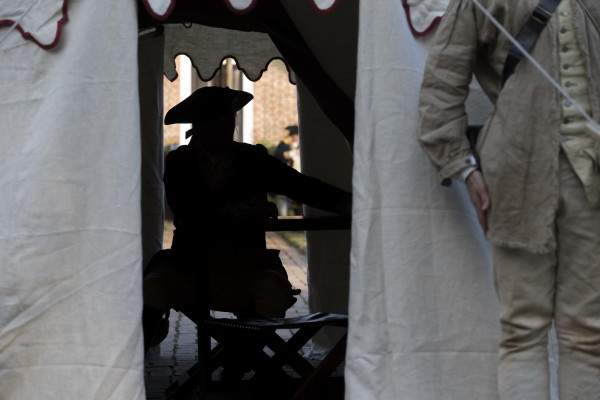 Visiting Washington’s headquarters at the Wythe House, it’s worth remembering that a Patriot victory over the British forces was by no means a foregone conclusion. In the preceding months (and longer), the Continental Army had been pushed to its limits, poorly paid and supplied, and even Washington expressed doubt, writing “We are at the end of our tether… now or never our deliverance must come.”
Visiting Washington’s headquarters at the Wythe House, it’s worth remembering that a Patriot victory over the British forces was by no means a foregone conclusion. In the preceding months (and longer), the Continental Army had been pushed to its limits, poorly paid and supplied, and even Washington expressed doubt, writing “We are at the end of our tether… now or never our deliverance must come.”
Walk through the Wythe House headquarters to see the family home transformed into a military outpost: where the generals shared a meal, where maps were laid out to plan the siege, where Washington slept at night (with Billy Lee, his enslaved assistant, nearby).
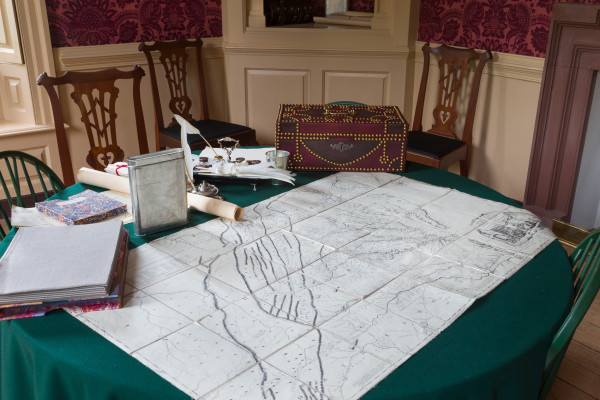 Then head into the backyard, where Washington’s marquis tent is set up and the generals are deliberating. What’s the proper strategy for defeating Cornwallis? What are the logistics for taking care of and leading thousands of troops? Can they trust the French navy force to stay and help?
Then head into the backyard, where Washington’s marquis tent is set up and the generals are deliberating. What’s the proper strategy for defeating Cornwallis? What are the logistics for taking care of and leading thousands of troops? Can they trust the French navy force to stay and help?
Washington and Lafayette will be there, but so will Gen. Henry Knox (hero of the siege of Boston and future secretary of war) and Gen. Benjamin Lincoln (veteran of Saratoga and, disastrously, the surrender of Charleston), among others. You’ll find the Patriot leaders on the grounds of the Wythe House from 11 a.m. to 1 p.m. and 2:30 p.m. to 4 p.m. Saturday, and 10:30 a.m to 12 p.m. and 1:30 p.m. to 3 p.m. Sunday.
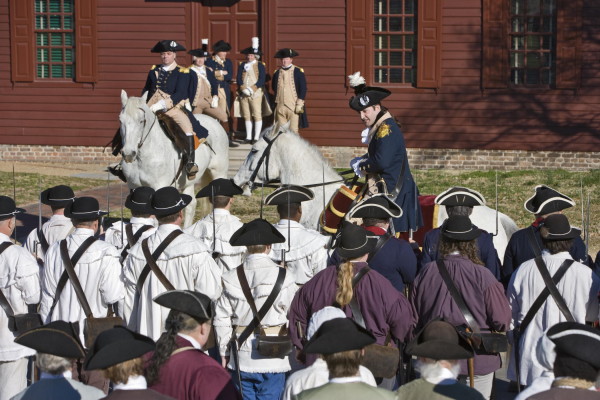 If you are curious about women’s participation in the war effort, there are opportunities to learn about nurses and camp followers, or take a Women of Williamsburg Walking Tour.
If you are curious about women’s participation in the war effort, there are opportunities to learn about nurses and camp followers, or take a Women of Williamsburg Walking Tour.
The weekend is too full of immersive experiences to list everything. Be on the lookout (and check the schedule!) for opportunities to help assemble musket cartridges, see an accused spy interrogated, play colonial games, and help construct fortifications. Think how impressed your friends will be when you explain that what they’re looking at is a fascine, not a gabion.
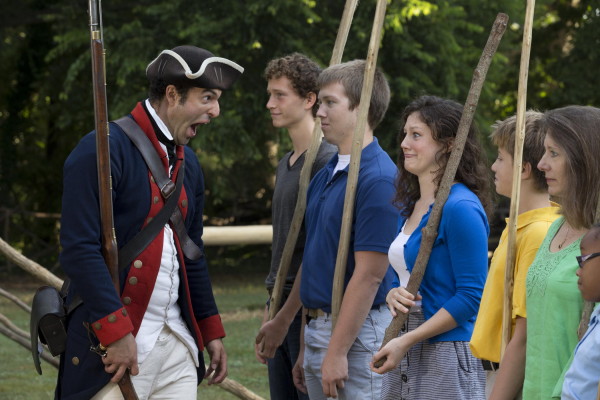 Come nightfall, soldiers will patrol the town and keep watch. But there’s something special planned for Saturday evening. Hie thee to the Governor’s Palace at 8 of the clock, and watch as four iconic buildings—the Governor’s Palace, the Courthouse, the Magazine, and the Capitol—are illuminated for the first time. A torch lit march we’re calling Light, Liberty & the Pursuit of Happiness will guide the crowd to each location, where a few appropriately patriotic words and the fifes and drums will precede each building’s lighting.
Come nightfall, soldiers will patrol the town and keep watch. But there’s something special planned for Saturday evening. Hie thee to the Governor’s Palace at 8 of the clock, and watch as four iconic buildings—the Governor’s Palace, the Courthouse, the Magazine, and the Capitol—are illuminated for the first time. A torch lit march we’re calling Light, Liberty & the Pursuit of Happiness will guide the crowd to each location, where a few appropriately patriotic words and the fifes and drums will precede each building’s lighting.
Buildings will continue to be illuminated at night, but you can say you were among the first to see it.
So what came after the preparations for Yorktown?
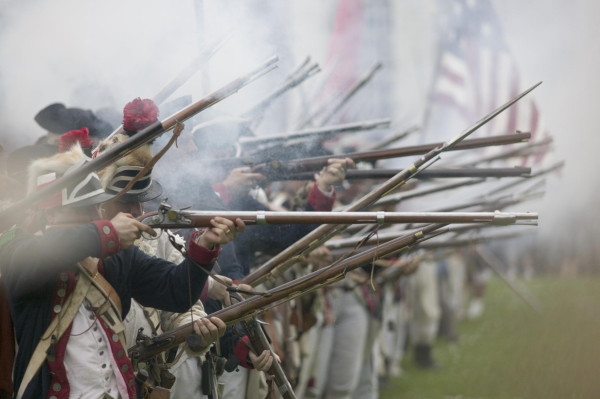 The French navy stayed put on the bay, cutting off the British escape route as the American forces laid siege to Yorktown. In days of battle, they drew the noose tighter until forcing a British surrender on October 19, 1781.
The French navy stayed put on the bay, cutting off the British escape route as the American forces laid siege to Yorktown. In days of battle, they drew the noose tighter until forcing a British surrender on October 19, 1781.
And it started in Williamsburg.
Military regiments scheduled to be in Williamsburg include: 2nd Virginia Regiment; 7th Virginia Regiment; 1st Maryland Regiment; 2nd North Carolina Regiment; 6th North Carolina Regiment; Kingsbury’s North Carolina Artillery; 5th Connecticut Regiment; 1st Delaware Regiment; 3rd Pennsylvania Regiment; The German Regiment; and (His Majesty’s) Detached Hospital.

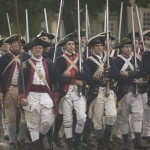
Rich says
It’s events like these that make me wish that I owned a USS Enterprise transporter. I was involved in some of these types of events while in the NPS in MA back during the Bicentennial and they are educational and great fun.
Well done CW, maybe next year.
Thanks, I hope we’ll see you soon.
Looks like fun. Wish I could attend. The photo of the kids being bawled out by the drill sergeant is priceless.
I love that picture too, It’s all about immersion here!
It sounds like the plans made to illustrate these events will be very exciting. One thing I have often wondered about-the true character of Cornwallis, the man. In film and print, he is made out to be heartless and grimly detached from the effects of the conflict. Does that truly represent his character, from what is known of him? We are told much about the primary figures in the American side, but what about the British?
I think Cornwallis gets a lot of grief from the fact that he didn’t show up in person at the British surrender at Yorktown. Banastre Tarleton fares much worse, of course. There’s actually a great book about the British leadership if you want to decide for yourself: Andrew O’Shaughnessy’s “The Men Who Lost America.